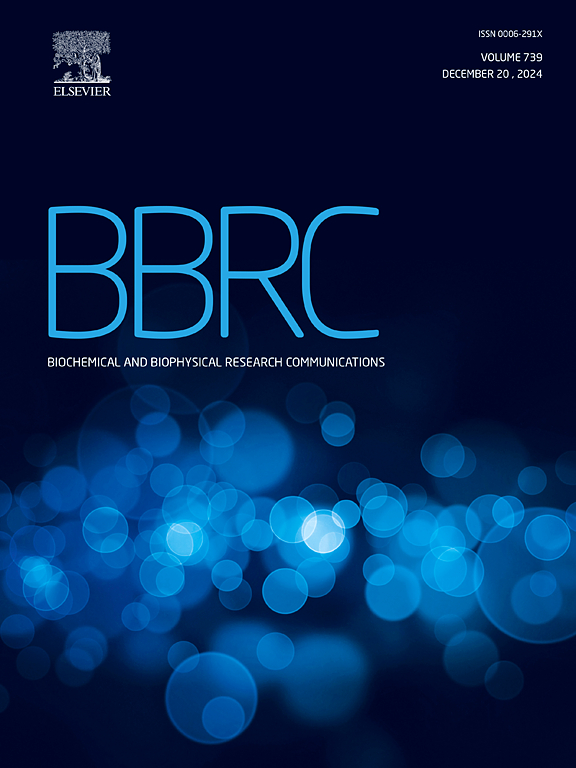s -氯胺酮通过抑制神经炎症、突触恢复和BDNF通路激活来改善小鼠脑卒中后抑郁
IF 2.5
3区 生物学
Q3 BIOCHEMISTRY & MOLECULAR BIOLOGY
Biochemical and biophysical research communications
Pub Date : 2025-05-08
DOI:10.1016/j.bbrc.2025.151965
引用次数: 0
摘要
卒中后抑郁症患者的治疗选择是有限的。尽管ssri类药物是最常用的抗抑郁药物,但它们起效缓慢,副作用或禁忌症的风险较高,因此迫切需要开发针对PSD患者需求的速效和高度特异性的抗抑郁药物。因此,氯胺酮引起了人们的关注。虽然氯胺酮在许多研究中显示出快速的抗抑郁作用,但它是否能改善PSD仍不清楚,其治疗PSD的分子和细胞机制在很大程度上是难以捉摸的。在本研究中,我们采用光血栓和慢性约束应激诱导的PSD临床前模型来研究s -氯胺酮的作用。本研究表明,PSD后第一天单次急性腹腔注射10 mg/kg s -氯胺酮可显著缓解PSD小鼠的抑郁样行为。此外,这种改善至少连续保持了5天。机制上,s -氯胺酮降低内侧前额叶皮层(mPFC)中的促炎细胞因子,减轻突触损伤(通过增加树突棘密度、SYP和PSD-95表达证明)。此外,s -氯胺酮处理上调脑源性神经营养因子(BDNF)、原肌球蛋白相关激酶B (TrkB)、磷酸化丝氨酸/苏氨酸特异性蛋白激酶B (p-Akt)、磷酸化细胞外信号调节激酶(p-Erk)、磷酸化钙/钙调素依赖性蛋白激酶II (p-CaMKII)和磷酸化cAMP反应元件结合蛋白(p-CREB)的表达。总的来说,s -氯胺酮通过其抗炎、突触增强和BDNF通路调节作用显示出治疗PSD的希望。本研究增强了我们对PSD病理机制的认识,并为其治疗提供了新的见解。本文章由计算机程序翻译,如有差异,请以英文原文为准。
S-ketamine ameliorates post-stroke depression in mice via attenuation of neuroinflammation, synaptic restoration, and BDNF pathway activation
The available therapeutic options for post-stroke depression patients are limited. Although SSRIs are the most commonly prescribed antidepressants, their slow onset of action and the higher risk of adverse effects or contraindications have led to an urgent need to develop fast-acting and highly specific antidepressants tailored to the needs of PSD patients. Therefore, ketamine has drawn attention. While ketamine has been shown to exert rapid antidepressant effects in numerous studies, whether it can ameliorate PSD remains unclear, and the molecular and cellular mechanisms underlying its therapeutic action in PSD are largely elusive. In this study, we used a PSD preclinical model induced by photothrombosis and chronic restraint stress to investigate the effects of S-ketamine. The present study demonstrates that a single acute intraperitoneal injection of 10 mg/kg S-ketamine on the first day after PSD significantly alleviates depressive-like behaviours in PSD mice. In addition, this improvement was maintained for at least five consecutive days. Mechanistically, S-ketamine reduced pro-inflammatory cytokines in the medial prefrontal cortex (mPFC), mitigated synaptic damage (evidenced by increased dendritic spine density, SYP, and PSD-95 expression). Furthermore, S-ketamine treatment upregulated the expression of brain-derived neurotrophic factor (BDNF), tropomyosin related kinase B (TrkB), phosphorylated serine/threonine-specific protein kinase B (p-Akt), phosphorylated extracellular signal–regulated kinase (p-Erk), phosphorylated calcium/calmodulin-dependent protein kinase II (p-CaMKII), and phosphorylated cAMP response element binding protein (p-CREB). Overall, S-ketamine shows promise for PSD treatment through its anti-inflammatory, synaptic enhancing, and BDNF pathway modulating effects. This research enhances our understanding of the pathological mechanisms underlying PSD and provides new therapeutic insights for its treatment.
求助全文
通过发布文献求助,成功后即可免费获取论文全文。
去求助
来源期刊
CiteScore
6.10
自引率
0.00%
发文量
1400
审稿时长
14 days
期刊介绍:
Biochemical and Biophysical Research Communications is the premier international journal devoted to the very rapid dissemination of timely and significant experimental results in diverse fields of biological research. The development of the "Breakthroughs and Views" section brings the minireview format to the journal, and issues often contain collections of special interest manuscripts. BBRC is published weekly (52 issues/year).Research Areas now include: Biochemistry; biophysics; cell biology; developmental biology; immunology
; molecular biology; neurobiology; plant biology and proteomics

 求助内容:
求助内容: 应助结果提醒方式:
应助结果提醒方式:


